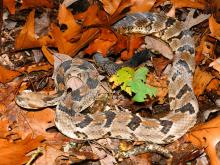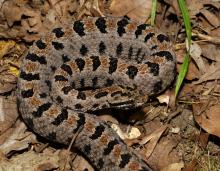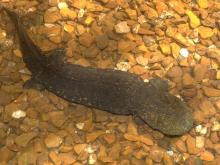Reptiles and Amphibians
Media

Species Types
Scientific Name
Ambystoma maculatum
Description
The spotted salamander is one of Missouri's six species of mole salamanders. It is slate black with two irregular rows of rounded yellow spots from the head onto the tail. It occurs in forests in the southern two-thirds of the state.
Media

Species Types
Scientific Name
Pantherophis ramspotti
Description
The western foxsnake is a moderately large snake with distinct brown blotches. In Missouri, it is rare and found only in our far northwestern counties.
Media

Species Types
Scientific Name
Sonora semiannulata semiannulata
Description
The variable groundsnake is a small species with smooth, shiny scales and highly variable coloration. In Missouri, it is mostly restricted to open, rocky hillsides of the southwestern corner of the state.
Media

Species Types
Scientific Name
Crotalus horridus
Description
Missouri’s largest venomous snake, the timber rattlesnake, is dangerously venomous, but there are few cases of rattlesnake bites in our state. It frequents rough country, is mostly nocturnal in summer, and few Missourians ever encounter it.
Media

Species Types
Scientific Name
Sistrurus miliarius streckeri
Description
The western pygmy rattlesnake is small and colorful, with a slender tail and tiny rattle. Its vibrating rattle is a faint buzz that sounds like a grasshopper. In Missouri, it occurs in the eastern Ozarks and in some counties bordering Arkansas.
Media

Species Types
Scientific Name
Agkistrodon contortrix
Description
The eastern copperhead is the most common venomous snake in Missouri. Its color varies from grayish brown to pinkish tan, with distinctive hourglass-shaped crossbands.
Media

Species Types
Scientific Name
Nerodia sipedon sipedon (northern watersnake) and N. s. pleuralis (midland watersnake)
Description
The northern watersnake and midland watersnake are Missouri's two subspecies of common watersnake. Together they occur statewide. Color is variable: gray, tan, or reddish brown with dark crossbands or blotches. The belly is cream-colored with red, brown, or black spots or half-moon markings.
Media

Species Types
Scientific Name
Plethodon serratus
Description
The southern red-backed salamander is small and slender, with a distinct, narrow, red or orange stripe along the back that has saw-toothed edges. It hides under rocks, mosses, and rotten logs in Ozark forests.
Media

Species Types
Scientific Name
Necturus maculosus maculosus
Description
Mudpuppies are aquatic salamanders that have plumelike external gills throughout their entire lives. They’re found in the southern half and along the eastern edge of Missouri.
Media

Species Types
Scientific Name
Cryptobranchus alleganiensis alleganiensis
Description
The eastern hellbender is a large, entirely aquatic salamander with a wide, flat head, small, lidless eyes, and soft folds of skin on the sides. In Missouri, it occurs in the northern Ozark highlands in spring-fed rivers that drain north into the Missouri and Meramec river drainages.
See Also
About Reptiles and Amphibians in Missouri
Missouri’s herptiles comprise 43 amphibians and 75 reptiles. Amphibians, including salamanders, toads, and frogs, are vertebrate animals that spend at least part of their life cycle in water. They usually have moist skin, lack scales or claws, and are ectothermal (cold-blooded), so they do not produce their own body heat the way birds and mammals do. Reptiles, including turtles, lizards, and snakes, are also vertebrates, and most are ectothermal, but unlike amphibians, reptiles have dry skin with scales, the ones with legs have claws, and they do not have to live part of their lives in water.





















